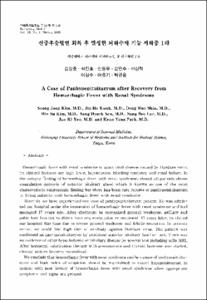신증후출혈열 회복 후 발생한 뇌하수체 기능 저하증 1례
- Keimyung Author(s)
- Park, Keun Yong
- Journal Title
- Keimyung Medical Journal
- Issued Date
- 1999
- Volume
- 18
- Issue
- 1
- Abstract
- Hemorrhagic fever with renal syndrome is acute viral disease caused by Hantaan virus, its clinical features are high fever, hypotension, bleeding tendency and renal failure. In the autopsy finding of hemorrhagic fever with renal syndrome, almost all patients shows coagulation necrosis of anterior pituitary gland which is known as one of the most characteristic microscopic finding but there has been rare reports of panhypopituitarysm in living patients with hemorrhagic fever with renal syndrome.
Recently we have experienced one case of panhypopituitarysm patient. He was admitted our hospital under the impression of hemorrhagic fever with renal syndrome and had managed 17 years ago. After discharge he recognized general weakness, axillary and pubic hair loss but he didn't have any evalutation or treatment. 17 years later, he visited our hospital this time due to severe general weakness and febrile sensation. In patients serum, we could find high titer of antibody against Hantaan virus. The patient was confirmed as panhypopituitarysm by combined anterior pituitary function test. There was no evidence of other hypothalamic or pituitary disease by several test including sella MRI. After hormonal substitution therapy with prednisolone and thyroid hormone was started, clinical picture became normalized.
We conclude that hemorrhagic fever with renal syndrome can be a cause of panhypopituitarysm and high index of suspicion should be maintained to detect hypopituitarysm in patient with past history of hemorrhagic fever with renal syndrome when appropriate symptoms and signs are present.
- Alternative Title
- A Case of Panhypopituitarysm after Recovery from He
- Keimyung Author(s)(Kor)
- 박근용
- Publisher
- Keimyung University School of Medicine
- Citation
- 김민수 et al. (1999). 신증후출혈열 회복 후 발생한 뇌하수체 기능 저하증 1례. Keimyung Medical Journal, 18(1), 156–163.
- Type
- Article
- 파일 목록
-
-
Download
 18-156.pdf
기타 데이터 / 864.77 kB / Adobe PDF
18-156.pdf
기타 데이터 / 864.77 kB / Adobe PDF
-
Items in Repository are protected by copyright, with all rights reserved, unless otherwise indicated.